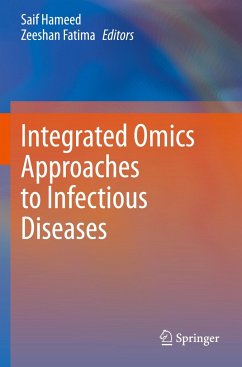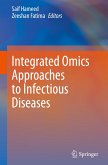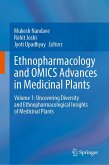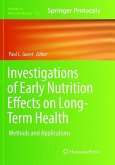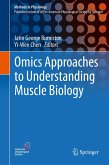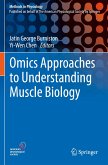Integrated Omics Approaches to Infectious Diseases
Herausgegeben:Hameed, Saif; Fatima, Zeeshan
Integrated Omics Approaches to Infectious Diseases
Herausgegeben:Hameed, Saif; Fatima, Zeeshan
- Broschiertes Buch
- Merkliste
- Auf die Merkliste
- Bewerten Bewerten
- Teilen
- Produkt teilen
- Produkterinnerung
- Produkterinnerung
This book examines applications of multi-omics approaches for understanding disease etiology, pathogenesis, host-pathogen interactions. It also analyzes the genetics, immunological and metabolic mechanisms underlying the infections. The book also explores genomics, transcriptomics, translational-omics, and metabolomics approaches to understand the pathogenesis and identify potential drug targets. It reviews the role of epigenetic reprogramming in shaping the host-pathogen interactions and presents bioinformatics application in the identification of drug targets. Further, it examines the…mehr
Andere Kunden interessierten sich auch für
![Integrated Omics Approaches to Infectious Diseases Integrated Omics Approaches to Infectious Diseases]() Integrated Omics Approaches to Infectious Diseases149,99 €
Integrated Omics Approaches to Infectious Diseases149,99 €![Clinical Metabolomics Applications in Genetic Diseases Clinical Metabolomics Applications in Genetic Diseases]() Clinical Metabolomics Applications in Genetic Diseases112,99 €
Clinical Metabolomics Applications in Genetic Diseases112,99 €![Ethnopharmacology and OMICS Advances in Medicinal Plants Volume 1 Ethnopharmacology and OMICS Advances in Medicinal Plants Volume 1]() Ethnopharmacology and OMICS Advances in Medicinal Plants Volume 1112,99 €
Ethnopharmacology and OMICS Advances in Medicinal Plants Volume 1112,99 €![Investigations of Early Nutrition Effects on Long-Term Health Investigations of Early Nutrition Effects on Long-Term Health]() Investigations of Early Nutrition Effects on Long-Term Health65,99 €
Investigations of Early Nutrition Effects on Long-Term Health65,99 €![Omics Approaches to Understanding Muscle Biology Omics Approaches to Understanding Muscle Biology]() Omics Approaches to Understanding Muscle Biology104,99 €
Omics Approaches to Understanding Muscle Biology104,99 €![Principles and Advances in Population Neuroscience Principles and Advances in Population Neuroscience]() Principles and Advances in Population Neuroscience149,99 €
Principles and Advances in Population Neuroscience149,99 €![Omics Approaches to Understanding Muscle Biology Omics Approaches to Understanding Muscle Biology]() Omics Approaches to Understanding Muscle Biology75,99 €
Omics Approaches to Understanding Muscle Biology75,99 €-
-
-
This book examines applications of multi-omics approaches for understanding disease etiology, pathogenesis, host-pathogen interactions. It also analyzes the genetics, immunological and metabolic mechanisms underlying the infections. The book also explores genomics, transcriptomics, translational-omics, and metabolomics approaches to understand the pathogenesis and identify potential drug targets. It reviews the role of epigenetic reprogramming in shaping the host-pathogen interactions and presents bioinformatics application in the identification of drug targets. Further, it examines the potential applications of RNA sequencing and non-coding RNA profiling to identify the pathogenesis. Lastly, it offers the current challenges, technological advances, and prospects of using multi-omics technologies in infectious biology.
Produktdetails
- Produktdetails
- Verlag: Springer / Springer Nature Singapore / Springer, Berlin
- Artikelnr. des Verlages: 978-981-16-0693-9
- 1st edition 2021
- Seitenzahl: 564
- Erscheinungstermin: 21. Juli 2022
- Englisch
- Abmessung: 235mm x 155mm x 31mm
- Gewicht: 844g
- ISBN-13: 9789811606939
- ISBN-10: 9811606935
- Artikelnr.: 64212821
- Herstellerkennzeichnung Die Herstellerinformationen sind derzeit nicht verfügbar.
- Verlag: Springer / Springer Nature Singapore / Springer, Berlin
- Artikelnr. des Verlages: 978-981-16-0693-9
- 1st edition 2021
- Seitenzahl: 564
- Erscheinungstermin: 21. Juli 2022
- Englisch
- Abmessung: 235mm x 155mm x 31mm
- Gewicht: 844g
- ISBN-13: 9789811606939
- ISBN-10: 9811606935
- Artikelnr.: 64212821
- Herstellerkennzeichnung Die Herstellerinformationen sind derzeit nicht verfügbar.
Dr. Saif Hameed is currently an Associate Professor at Amity Institute of Biotechnology, Amity University, Haryana. Dr. Hameed did his Bachelor's from the University of Delhi and Masters from Jamia Hamdard and completed his doctoral studies in Life Sciences from Jawaharlal Nehru University. He also worked as a visiting scholar in Institute für Mikrobiologie, Heinrich-Heine-Universität, Düsseldorf, Germany, in 2008. Dr. Hameed has received the Young Scientist award from the Science and Engineering Research Board, Department of Science and Technology, New Delhi. Dr. Hameed is actively engaged in research in infectious diseases particularly multidrug resistance (MDR) in pathogenic fungi. He has around 50 peer-reviewed papers to his credit in high repute journals, 3 books, 21 book chapters, and 25 popular articles, with 2 of them as 'cover story' and guided 4 doctoral students. He is a life member of the Association of Microbiologists of India (AMI) and the International Societyfor Infectious Diseases (ISID). Dr. Zeeshan Fatima is currently working as Associate Professor at Amity Institute of Biotechnology, Amity University, Haryana. Dr. Fatima did her Bachelor's and Masters from Banaras Hindu University and earned her doctoral degree in Biochemistry from Aligarh Muslim University. She has held research positions under nationally and internationally funded research projects, including her Research Associateship at BHU and JNU and postdoctoral training from the University of Cincinnati, Ohio, USA. Dr. Fatima has received two Young Scientist awards under Fast Track and Women Scientist Schemes, respectively, from the Science and Engineering Research Board, Department of Science and Technology, New Delhi. She is actively engaged in infectious diseases research, particularly on multidrug resistance in human pathogens, Mycobacterium tuberculosis and Candida albicans. She has 3 books and around 45 peer-reviewed papers to her credit in journals of highrepute and supervised 4 doctoral thesis. She is a life member of the Association of Microbiologists of India (AMI), Society of Biological Chemists (SBC), India and the International Society for Infectious Diseases (ISID).
Chapter 1. Geno-Informatics for Prediction of Virulence and Drug Resistance in Bacterial Pathogens.- Chapter 2. Next Generation Sequencing: Challenges and Opportunities in Tuberculosis Research.- Chapter 3. Deciphering the role of epigenetic reprogramming in host-pathogen interactions.- Chapter 4. Genomic evidence provides the understanding of SARS-CoV-2 composition, divergence and diagnosis.- Chapter 5. Importance of Next Generation Sequencing in Viral Diagnostics.- Chapter 6. Bioinformatics application in CoVID19.- Chapter 7. Emerging Transcriptomics approaches to decipher Mycobacterial complexities.- Chapter 8. Microarrays: A road map to uncover host pathogen interactions.- Chapter 9. Transcriptional Approach in the Identification of Drug Targets in Candida spp.- Chapter 10. Non-Coding RNA profiling: Potential Application in Infectious Diseases.- Chapter 11. RNA-seq analysis strategies to understand viral pathogenesis.- Chapter 12. Various Transcriptomic approaches & their applications to study small non-coding RNAs in Dengue and other viruses.- Chapter 13. Transcriptomic Approaches in Understanding Sars-COV-2 Infection.- Chapter 14. miRNA target prediction: Overview and applications.- Chapter 15. A Glimpse into Peptidomic Approach.- Chapter 16. Molecular mechanism of action of antimicrobial agents against clinically important human pathogens: A proteomic approach.- Chapter 17. Exploration of the mycobacterial proteome in the pathogenesis of TB: A perspective.- Chapter 18. Pathogenesis of Staphylococcus aureus and proteomic strategies for the identification of drug targets.- Chapter 19. Proteomics in the study of Host-Pathogen interactions.- Chapter 20. Significance of post-translational modifications in Apicomplexan parasites.- Chapter 21. An introduction to computational pipelines for analyzing untargeted metabolomics data for Leishmaniasis.- Chapter 22. Metabolomics: PromisingTool to Study Disease Biomarkers and Host-Pathogen Interactions.- Chapter 23. Lipidomics to study the role of lipid droplets in host-pathogen interactions.- Chapter 24. Lipid structure, function and lipidomic applications.- Chapter 25. Nanoparticles as Therapeutic Nanocargos affecting Epigenome of Microbial Biofilms.- Chapter 26. Malaria in the era of OMICS: Challenges and Way forward.- Chapter 27. Omics Approaches for Infectious Diseases.- Chapter 28. Pathogen-Omics: challenges and prospects in research and clinical settings.
Chapter 1. Geno-Informatics for Prediction of Virulence and Drug Resistance in Bacterial Pathogens.- Chapter 2. Next Generation Sequencing: Challenges and Opportunities in Tuberculosis Research.- Chapter 3. Deciphering the role of epigenetic reprogramming in host-pathogen interactions.- Chapter 4. Genomic evidence provides the understanding of SARS-CoV-2 composition, divergence and diagnosis.- Chapter 5. Importance of Next Generation Sequencing in Viral Diagnostics.- Chapter 6. Bioinformatics application in CoVID19.- Chapter 7. Emerging Transcriptomics approaches to decipher Mycobacterial complexities.- Chapter 8. Microarrays: A road map to uncover host pathogen interactions.- Chapter 9. Transcriptional Approach in the Identification of Drug Targets in Candida spp.- Chapter 10. Non-Coding RNA profiling: Potential Application in Infectious Diseases.- Chapter 11. RNA-seq analysis strategies to understand viral pathogenesis.- Chapter 12. Various Transcriptomic approaches & their applications to study small non-coding RNAs in Dengue and other viruses.- Chapter 13. Transcriptomic Approaches in Understanding Sars-COV-2 Infection.- Chapter 14. miRNA target prediction: Overview and applications.- Chapter 15. A Glimpse into Peptidomic Approach.- Chapter 16. Molecular mechanism of action of antimicrobial agents against clinically important human pathogens: A proteomic approach.- Chapter 17. Exploration of the mycobacterial proteome in the pathogenesis of TB: A perspective.- Chapter 18. Pathogenesis of Staphylococcus aureus and proteomic strategies for the identification of drug targets.- Chapter 19. Proteomics in the study of Host-Pathogen interactions.- Chapter 20. Significance of post-translational modifications in Apicomplexan parasites.- Chapter 21. An introduction to computational pipelines for analyzing untargeted metabolomics data for Leishmaniasis.- Chapter 22. Metabolomics: PromisingTool to Study Disease Biomarkers and Host-Pathogen Interactions.- Chapter 23. Lipidomics to study the role of lipid droplets in host-pathogen interactions.- Chapter 24. Lipid structure, function and lipidomic applications.- Chapter 25. Nanoparticles as Therapeutic Nanocargos affecting Epigenome of Microbial Biofilms.- Chapter 26. Malaria in the era of OMICS: Challenges and Way forward.- Chapter 27. Omics Approaches for Infectious Diseases.- Chapter 28. Pathogen-Omics: challenges and prospects in research and clinical settings.

